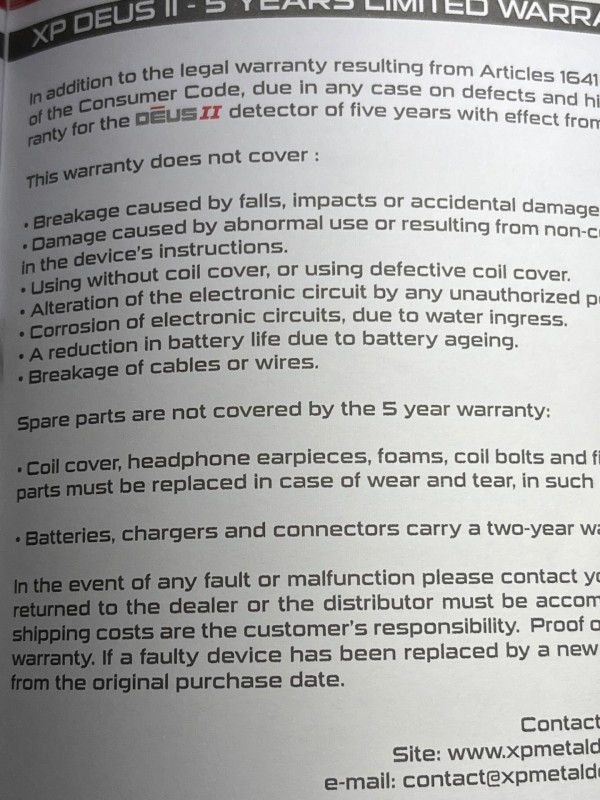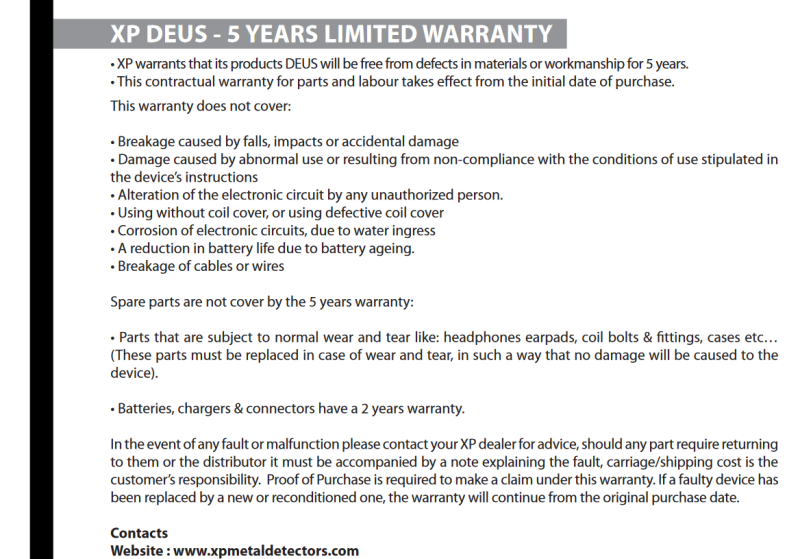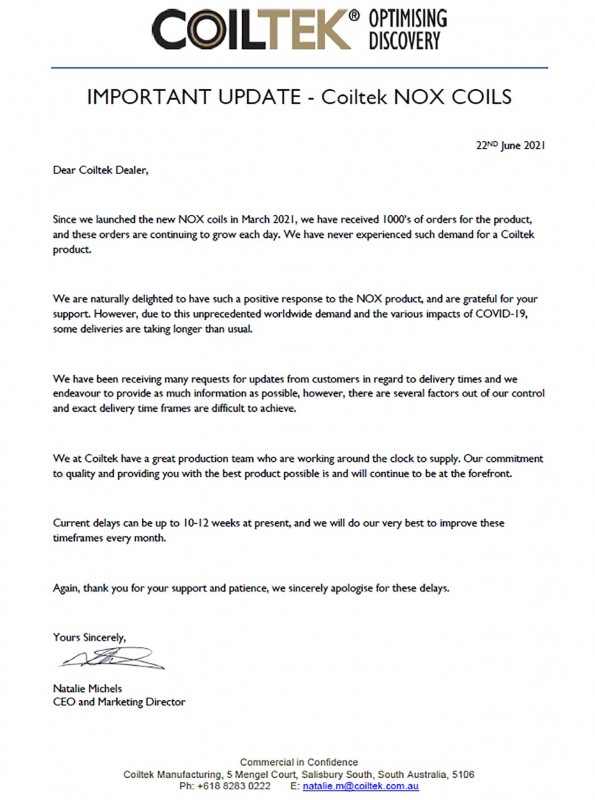-
Posts
41 -
Joined
-
Last visited
Content Type
Forums
Detector Prospector Home
Detector Database
Downloads
Posts posted by AirmetTango
-
-
On 1/6/2023 at 5:51 AM, fishersari said:
I did an air test between these 2 modes by using a high conductor copper coin (ID-91). The AT general has depth advantage over AT High conductor mode around an inch. Both mode used same setting: sensitivity - 18, recovery speed - 4, ground balance - 0, audio theme Normal + Simple. AT High conductor should go deeper? Did I do or think wrong? Would love to know your thought and if possible same air test to compare result. Thank you in advance
On 1/6/2023 at 6:31 PM, fishersari said:It caught me by surprise that the general mode is deeper about an inch compare to HC mode for high conductive coin. I mean the HC should be deeper than General even on air test?. Assuming its using much lower frequency weight in than the general mode right? I will test it today at relic site.. If general mode is still deeper than HC for high conductive target... I don't know maybe there is something wrong with my machine
I don’t think there’s anything wrong with your machine - I honestly think you’re just seeing a very real demonstration of how air tests can be very misleading. As you probably know, high frequency machines do very well on low conductors (ie, small targets). But in reality, high frequency machines do very well on all targets - high conductors (big targets) as well as low conductors - in air tests. It’s the ground that gives a high frequency machine problems as the ground matrix much more quickly attenuates a high frequency signal. And the more mineralized the ground, the worse the problem gets as the high frequency lights up all the magnetite and other mineralization that a low frequency machine is less susceptible to. This is why high frequency machines tend to get used for gold detectors (40 to 70 kHz machines targeting small gold, for example), but they get terrible depth in mineralized ground.
Low frequency machines also air test quite well, although for several reasons it wouldn’t be surprising for it not to air test as well as high frequency. Where the low frequency shines is in the ground, for certain sized targets. Low frequency punches through any mineralization better, providing better depth, especially as mineralization increases compared to a high frequency machine…the caveat is, you absolutely will lose smaller (less conductive) targets that the low frequency just can’t hit.
So putting it all together, AT General is weighted as higher frequency compared to AT HC, which Minelab says is weighted to low frequency. Based on what I mentioned above, it makes sense that the two modes will air test similarly and maybe even with an advantage to high frequency depending on the size and/or conductivity of the sample target. But bury a high conductor near the edge of good detection depth for AT HC in highly mineralized ground, and you may be surprised to hear silence when you switch to AT General.
But you don’t have to take my word for it - Steve Herschbach covered this concept in fantastic detail in his excellent post about Target ID versus Target Size here:
Target ID More About Target Size Than Type Of Metal
Further down, @Steve Herschbach even relates a story about his Fisher F75 vs a Fisher Gold Bug 2 that directly relates to your air test. The whole thread is invaluable reading!
-
I’m a little worried about the relative complexity of the arm cuff design and attachment from the standpoint that it might be very difficult to get an aftermarket replacement cuff adequately designed for use on the stock shaft. I never had the cuff break on my EQ800, but I also never gave it much of a chance…within a month of purchasing my 800, I replaced the shaft with a CF shaft and replaced the cuff with an indestructible, heavy aluminum cuff. Does the 900 cuff design look significantly stronger in person than the previous Equinox cuff? It’s hard to tell from just photos.
-
1 hour ago, Tometusns said:
Interesting...hopefully that's just a mistake. It appears possible that XP just cut-and-pasted from the non-waterproof XP Deus I manual to create the warranty section for the Deus II manual. Pretty big oversight not to remove that on a waterproof model...assuming it is an oversight. Here's the relevant page from the Deus I manual:
-
On 3/4/2022 at 1:57 AM, Cal_Cobra said:
We need that new $100B Intel manufacturing plant like yesterday.
I hear ya! The current official word is that the plant is expected to begin construction "some time" this year and be operational by 2025...unfortunately, with standard construction delays on a project that size, I'd be amazed if it's producing chips by 2027. As it is, Intel only just now made selections for the initial contractors: NBC4 Columbus: Intel Picks First 4 Construction Firms to Begin Work on Intel Plant. Doesn't bode well for a meaningful 2022 ground breaking, but I hope I'm wrong!
-
Why on Earth would anyone treat random YouTube content creators as a trusted news source?? Least of all, this particular clip from a guy with neon lights and lava lamps in the background who is worried about “economical” impacts based on “clippings” from a reporter he doesn’t even name and therefore also has absolutely zero credibility (although he does have a guitar). Just sensationalistic pseudo news/click bait/unsubstantiated amateur hour speculation, in my opinion, which reveals nothing credible about the true situation with the Legend, Nokia Makro, or even Turkey in general. My advice: get economic news from a real news source, then cross reference that news from at least a second true news source, then make an informed opinion. Looking at clips like these is no different than accepting the ravings of the average clueless guy on the street as gospel.
-
On 6/22/2021 at 4:57 PM, CPT_GhostLight said:
Just received this from my dealer for those that may be interested:
Coiltek Nox coils update June 2021 - Supply Delays.pdf 77.44 kB · 2 downloads
I got an email from my dealer on Thursday June 24 to let me know that my 10x5 is on the way with delivery by USPS expected on Monday June 28. Counting from the March 3 launch (again, I preordered a month prior to launch) that’s over 16 weeks delay, at least a full month longer than the 10-12 weeks Coiltek states in that letter dated June 22.
Regardless, I’m pleased mine is finally on the way, and hopefully their production is genuinely starting to catch up to their rather optimistic delay estimates.
-
On 6/9/2021 at 6:13 PM, Chase Goldman said:
... Anyway, here is the official statement from CoilTek:
IMPORTANT UPDATE - Coiltek NOX COILS
Since we launched the new NOX coils just 4 weeks ago on the 3rd of March 2021, we have received 1000’s orders for the product, and these orders are continuing to grow each day. We have never before experienced such demand for a Coiltek product.
We are naturally delighted to have such a positive response to the NOX product and we are grateful for your support. However, due to this unprecedented worldwide demand and the various impacts of COVID-19, deliveries are taking longer than usual.
Be assured, our worldwide distributors and dealers are doing the best they can and we are keeping in close contact with them. They are being updated regularly on availability and stock quantities.
We at Coiltek have a great production team and we are working around the clock to supply. Our commitment to quality and providing you with the best product possible is and will continue to be at the forefront.
Current delays can be up to 6-8 weeks. The best way to purchase a NOX coil is to contact your local Coiltek dealer and place an order. Again, thank you for your support and patience, we sincerely apologise for these delays.
The Team at Coiltek
-Emphasis is mine in the above quote-
While I appreciate Coiltek making an official statement on their website, I'd be much more impressed if they would update it a little more frequently. Case in point, the statement above was clearly put out around March 31/April 1, and delays have progressed to well over the 6-8 weeks they've indicated. I'm still waiting for mine, pre-ordered with a major dealer very early on Feb 3 - from the March 3 launch, that puts me at over 14 weeks. Maybe I just have a bad dealer, but he has no estimate whatsoever on shipments and availability, causing me to very much doubt how much Coiltek is really able to fulfill their statement that dealers "are being updated regularly on availability and stock quantities", beyond telling them that there is no availability.
I get it...there is unanticipated demand and unprecedented market forces at play, and manufacturing/supply chain logistics are backed up thanks to COVID and other factors. But that doesn't excuse Coiltek for making only one official statement, and then not updating that statement for over two months, when it's very evident that the situation is worse than the statement is admitting, at least for US customers. To me, that's disappointing customer relations, and leaves me with a poor first impression as a first time Coiltek customer. I don't mind waiting for a product when I understand why there's a delay and the manufacturer is communicating in a timely manner about those delays. I'm a firm believer in "underpromise and overdeliver" - so it's disturbing to me as a customer to see clearly outdated and stale information on the company website during what amounts to a customer service crisis for the company. To me it screams "we don't care, we've already got your pre-order money." From that perspective, I actually find it a bit laughable and obnoxious for them to exacerbate the crisis by adding "the best way to purchase a NOX coil is to contact your local Coiltek dealer and place an order." I see where the priority is.
Good, honest, and timely communication goes a long way. Some advice to Coiltek: Update that statement at least once every two weeks with a date stamp so customers don't have to do the math from launch, and put honest, maybe even conservative, delay estimates in there. If the delays vary significantly for a particular region (ie, the US or North America), say so, and give a brief explanation about why. A few honest sentences go a long way toward generating goodwill with customers. When a large customer block can see that their experiences are drastically different from the company's spin control, that's when a poor reputation starts to develop.
Just my honest 2 cents. I hope my coil arrives before Autumn, and I genuinely hope it's worth the wait.
-
On 6/1/2021 at 5:47 PM, sodbuster said:
I have a 5" x 10" on order for many weeks... have not heard of anyone getting one lately. Thought I'd gotten one last month from "Serious", and put it in my cart and paid for it, only to have the order cancelled. Too many buyers and not enough coils.
I'm afraid you've probably got a long wait ahead...I've had one on order with a major dealer since February 3, and I'm still waiting with no estimate of shipment date. I'm never the type that pre-orders stuff, but I decided to take a chance on the 5x10 coil. Now I remember why I should never pre-order anything! Oh well, live and re-learn for me, I guess 😏
-
23 hours ago, Steve Herschbach said:
It’s just a function of DD coils and the complex interplay of the electromagnetic fields at close proximity. You will actually get triple hits up close as all three major winding areas react. With distance the readings meld and get more predictable.
This article might help explain some of the quirks people observe. Getting consistent results is not as easy as people imagine, and was easier with old detectors. Equinox is literally seeing things too quickly and too accurately, reporting in real time what old detectors just glossed over, sometimes to their benefit.
http://www.fisherlab.com/hobby/davejohnson/SearchcoilfieldshapeApril2012.pdf
This is new stuff, and as Minelab learns and applies more advanced signal processing to what Multi-IQ is reporting, we can expect quite a bit of refinement to occur in the second generation Equinox. The first go is just a crude “proof of concept” in many ways, with lots of room to grow. I’m really excited by what’s coming next!
Thanks Steve - and very interesting article. I always knew that those profile and cross-section views of coil search fields were over simplified, but that article truly underscores how much more complex it really is!
Agreed - I'm quite pleased with my EQ800 (using since late 2018), but I have no doubt that as Multi-IQ concepts become even more mature, we can expect even more impressive capabilities in future iterations of Minelab's machines.
-
On 7/19/2020 at 12:58 PM, Steve Herschbach said:
I read with wide eyed wonder a thread on another forum where it is stated that with the high Vanquish iron bias setting, or higher Equinox iron bias settings, that a dime stacked on a nickel returns a ferrous result. This has been called a bug, and some rather strident demands are being made that Minelab do something about it “or suffer the consequences."...
Thanks for posting this, Steve - it's quite instructive for someone, like me, who is relatively new to detecting and still learning how all of the many different filters and settings on detectors truly work and interact with each other. I read a thread on another forum about a month ago that may well be the one you're talking about - upon reading it, I tested the scenario on my EQ800 on both a nickel/dime and a pulltab/dime stack. Frankly, I had to work pretty hard to duplicate what folks were making the stink about. I did find a surprising (to me) result depending on "depth", and I posted to that thread to ask about it, but no one ever responded to the question. Maybe someone here can shed some light on what I found:
When that thread first posted, I went out to the garage to try a dime/nickel stack, and at first I was left scratching my head - I couldn't duplicate the "problem" of the stack being reported as ferrous, even with my IB set at F2 9 (a setting I never use in the field - I typically hunt at F2 0). I consistently was getting expected non-ferrous readings/tones on the stack. After a time, I realized I was swinging with the coil roughly 5 to 6” above the dime/nickel stack the whole time. I also have a significant amount of EMI at my house, so I needed to turn my sensitivity down to 10 to quiet/stabilize the machine enough to do the test. On a whim, I swung the coil within an inch of the targets, and I finally duplicated solid -4 and -5 ferrous signals for the stack using F2 9 only.
So my question becomes, does anyone know of an explanation for the detector interpreting the signal more accurately with increased “depth” in this situation? When using the highest iron bias setting on the EQ800, the detector seems to report the tone/VDI in the correct range at larger distances rather than smaller distances for this particular target type (nickel/dime stack, or even pull tab/dime stack). I'm not concerned about it being a "bug" - I'm just curious, as a relative newbie, if there's something about this behavior that can teach me something useful about how the detector works and/or how the settings interrelate that I can use in the field? Or maybe since I generally hunt at IB 0, I can just forget about it as an interesting quirk? 😄 -
I've only been detecting for a couple years and I've only found 5 war nickels total (just one with my recently acquired EQ800), but I've found their VDIs to be quite interesting. The first four that I found were with Garrett machines: the first one was in a coin spill so the numbers were naturally skewed, but the second and third each came up alone (and I mainly dug them because I got enough of a high tone from an iffy, deep signal to encourage me to dig on the assumption that I had a copper penny or a dime), and the fourth was the only war nickel I ever dug that was a solid "true" nickel tone all the way around the target (but it was shallow at only 2" down). Because of my experience with the other 3 war nickels reading high, I was at the point that I believed all war nickels read higher because of the silver content. But after the fourth one read "normal", I air tested each of my war nickels and was surprised to learn that despite the high tone component of my second and third war nickels in the ground, all of these four war nickels read in the "normal" nickel range out of the ground. I definitely rescanned all of my previous holes, so there's no doubt in my mind that there wasn't a missed target on the lone nickels.
My fifth war nickel was found with the EQ800, and it's my only war nickel that was a solid 21 both in and out of the ground - it's a 1945 P, so it isn't just the San Fran mint that has the occasional high nickel - Philadelphia apparently had some as well. Rescanning my other four war nickels with the EQ, I get a solid 13 for all of them (two 1943P, a 1944P, and a different 1945P).






Coil Cover For Coiltek 10x5 For Equinox?
in Minelab Equinox Forum
Posted
I feel your pain looking for a 10x5 coil cover! This past November I tried to hunt down a coil cover for mine after I sent my 10x5 in for warranty replacement, and I was surprised to find that they were nearly impossible to find on the web (at least in the US) - you certainly can't just order one off of Amazon like other coils I've owned, and most dealers in the US don't list them on their websites. However, I found that if you call dealers directly, they can find one for you. I sent you a message with specific options that might be able to help you.